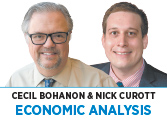Subscriber Benefit
As a subscriber you can listen to articles at work, in the car, or while you work out. Subscribe Now Making legislation is said to be like making sausage: You don’t want to know what goes into it. The federal tax bill signed into law at the end of last year is no exception. Make no mistake, we support its broad contours: a tax cut for households and, most important, a cut in the corporate tax rate. We are pleased it reduced a number of major tax loopholes—such as limitless deductibility of state and local taxes.
Making legislation is said to be like making sausage: You don’t want to know what goes into it. The federal tax bill signed into law at the end of last year is no exception. Make no mistake, we support its broad contours: a tax cut for households and, most important, a cut in the corporate tax rate. We are pleased it reduced a number of major tax loopholes—such as limitless deductibility of state and local taxes.
Yet our perspective as economists is tempered by political realism. Like our mentor the late Nobel-Prize-winning economist James Buchanan, we recognize politics is more a process of exchange than some idealistic pursuit of the abstract public interest. As President Obama said in 2009, elections have consequences—things change after elections, according to the interests of the winning coalition.
A recent analysis of the new federal tax code by the Urban-Brookings Tax Policy Center is instructive. Most individual taxpayers will see their tax obligation decline or remain the same in 2018. However, it is estimated that 6.4 percent of tax filers will see their tax bill increase in 2018 as result of the new law. And this percentage differs wildly by state. In New Jersey, it is estimated that 10.2 percent of all filers will see a tax hike, while in West Virginia, only 2.8 percent of tax filers will have increased tax liability. The percentage of Hoosiers expected to pay more comes in at a low 3.7 percent.
It turns out there are 34 states, like Indiana and West Virginia, where the percentage of filers expected to pay more next year is less than the national average. There are only 16 states where the percentage of filers expected to pay more exceeds the average.
We paired the Brookings tax data with state voting in the 2016 presidential election. Tellingly, Hillary Clinton won 12 of the 16 states that have an above-average percentage of tax filers experiencing tax increases. But she won only eight of the 34 states where the percentage of tax filers experiencing tax increases is below average. A coincidence? Maybe, but a simple statistical test indicates that the odds of this happening by random chance are under 1 percent—in fact, only 0.14 percent.
We are shocked—shocked!—that punitive politics might have played a role in the tax bill. Then again, not really.•
__________
Bohanon and Curott are professors of economics at Ball State University. Send comments to [email protected].
Please enable JavaScript to view this content.
